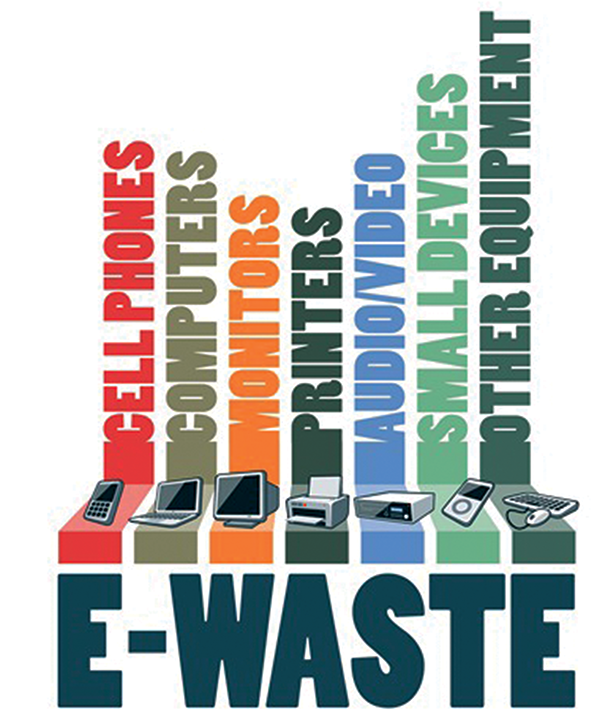 India is at a peculiar crossroad. On one hand, it has witnessed a tremendous growth of the electronic industry and on the other hand, it is grappling with the exponential growth of electronic or e-waste. India, which generates about 400,000 tonnes of waste annually, depends mostly on kabadiwalas to carry out the task of e-waste management in India. As they are mainly involved in dismantling the e-wastes rather than recycling disposed products, these wastes generate health issues.
India is at a peculiar crossroad. On one hand, it has witnessed a tremendous growth of the electronic industry and on the other hand, it is grappling with the exponential growth of electronic or e-waste. India, which generates about 400,000 tonnes of waste annually, depends mostly on kabadiwalas to carry out the task of e-waste management in India. As they are mainly involved in dismantling the e-wastes rather than recycling disposed products, these wastes generate health issues.
How e-waste contributes to global warming
Electrical and electronic waste (e-waste) currently contributes to the largest growing waste stream and is hazardous and complex. E-wastes like those of air conditioners, washing machines, microwave ovens, florescent lights and bulbs, and other electronic accessories and equipment are created every year and grow at 4% per year.
Large household appliances represent the largest proportion of e-waste (about 50%), followed by information and communications technology equipment (about 30%) and consumer electronics (about 10%). Electronic products contain several persistent, bio accumulative and toxic substances including heavy metals such as lead, nickel, chromium and mercury, and persistent organic pollutants (POPs) such as polychlorinated biphenyls (PCBs) and brominated flame retardants which contribute to global warming. Approximately 40% of the heavy metals found in landfills originate from electronic waste.
In developing countries like China, India, Ghana, and Nigeria, e-wastes are often recycled and sold illegally even if they are not fit to resold or reused. According to a report by the International Labour Organisation (ILO), “It is estimated that between 50 % and 80 % of e-waste collected is for recycling. It is either discarded into the general waste stream or, perhaps, illegally exported to crude e-waste recycling hotspots, which have been identified in Asian countries, such as China, India, and Pakistan, and in some African countries like Ghana and Nigeria. This situation is made worse by the current system of gathering information, in which second hand, used and waste products are, by and large, invisible to national statistics on production, sale and trade in goods.”
E-waste processes have resulted in environmental hazards like contamination and can be linked to depletion of soil and surface water. These toxins used in landfills may even be released into the atmosphere by the soil and this act as one of the major reasons of global warming. Lead, mercury, and cadmium when burnt directly goes into the atmosphere and ashes accumulate everywhere on the planet and eventually end up entering the food chain. When products containing plastics and PVC are burnt, they cause harmful dioxides to enter the atmosphere causing health issues like severe breathing difficulties, respiratory irritation, coughing, choking, pneumonitis, tremors, neuropsychiatric problems, convulsions, and coma and can lead to even death.
Business opportunities for e-waste management
E-waste recycling provides many business opportunities to recycle and reuse the waste after segregating the harmful
elements and disposing them safely. E-waste recycling results in recovery of many precious elements. In many aspects, e-waste recycling is like engaging in mining of precious metals and an interesting aspect of this mining process is that it only involves a physical intervention and is quite cheap. The precious metals were refined and used to make the electronic device and do not require further chemical processing during recycling. The precious elements only need physical separation from each other. This process can generate a lot of employment and is used by numerous entrepreneurs and start-up companies to treat e-waste and make it environment friendly. The e-waste recycling process initiates with the dismantling of components like motherboards, hard drives, cartridges, cabinets, cables, etc. Manual labour separates metal, glass and plastics from the components
followed by shredding of printed circuit board (PCB). Glass dismantling is done in a protective semi-automatic environment and by adhering to pollution control measures.
The recycling processes enable reutilizing the extracted materials for other products which may not be completely electronic in nature. For instance, Videocon makes CRTs of television using glass cullets. Secondary metal refiner uses metal scraps for smelting processes and makes pure steel, aluminum and copper for manufacturing of metallic appliances. Umicore Metal Refining (an integrated material recycling firm in Belgium) extracts metals like gold, silver, nickel, copper, bismuth, palladium and vanadium 8. The reverse supply chain of e-waste provides an array of opportunities to create a new market where further investment will lead to a win-win situation for all stakeholders.
According to National Electrical Manufacturers Association (NEMA) the precious elements that could be extracted from e-waste are:
Tin – from solder, coatings on component leads.
Copper – from copper wire, printed circuit board tracks,
component leads.
Aluminium – from electronic goods including electrolytic capacitors.
Iron – from steel chassis, cases, and fixings.
Germanium: from transistorized electronics (bipolar junction
transistors).
Silicon – from glass, transistors, ICs, printed circuit boards.
Nickel – from nickel-cadmium batteries.
Lithium – from lithium-ion batteries.
Zinc – from plated steel parts.
Gold – from connector plating in computer equipment.
Add new comment